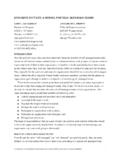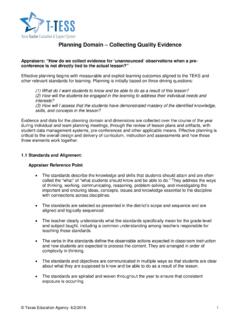Transcription of PLANNING FOR ORGANIZATIONAL TRANSFORMATION: A …
1 COPYRIGHT 1993 PARTNERS FOR PROGRESS. ALL RIGHTS FOR ORGANIZATIONAL TRANSFORMATION: A METHOD FOR NEW AND EXISTING TOTAL QUALITYMANAGEMENT EFFORTSLORI L. SILVERMAN, OWNERP artners for Progress1218 Carpenter StreetMadison, WI most organizations embark on a total quality effort they tend to "leap before they look."Sometimes a brief assessment of the organization and selection of a quality philosophy occurs priorto management training. Often when a management team does receive training it usually is in theform of a "canned" overview presentation. Management then rushes to start several problemsolving teams to quickly reap the "benefits" of its initial investment in total quality surprisingly, 12 to 18 months later the organization's total quality initiative stalls with no onereally understanding what has caused this outcome.
2 Once again, insufficient PLANNING has led time PLANNING for ORGANIZATIONAL transformation is critical to integrating qualityinto an organization's daily work, and short and long term strategies. In addition, knowingwhat specifically needs to be planned is as important as scheduling time for PLANNING . Whetheryou are part of an organization whose efforts have stalled or are just embarking on a totalquality management journey, the steps and the content of PLANNING for organizationaltransformation are paper outlines the need to plan for ORGANIZATIONAL transformation . It explains how toset the stage for PLANNING and conduct the PLANNING sessions that are necessary to fun-damentally change your organization to one that uses total quality management as the backdropfor all policies, procedures, systems, and strategies.
3 Finally, this paper will outline what isnecessary to sustain the ongoing management of this plan for ORGANIZATIONAL PLAN FOR ORGANIZATIONAL transformation ?For many if not all enterprises, moving to a total quality management approach requires afundamental change in how the organization is managed. This is akin to what has been labeled as aparadigm shift. A paradigm is a set of rules and regulations (written or unwritten) that does two COPYRIGHT 1993 PARTNERS FOR PROGRESS. ALL RIGHTS establishes or defines boundaries; tells you how to behave inside the boundaries in order to be successful (1).What this means is that a paradigm shift is a shift to a new game, a new playing field.
4 Theconcepts, tools, and methods of total quality management are a new set of running rules for anorganization which must cause it to re-think all of its policies, practices, procedures, and to many quality approaches are these basic concepts:nviewing work activities as a series of work processes rather than discrete, unrelatedtasks;ndesigning work processes and products/services to meet customer requirements ( ,expectations, and known and unknown needs);nusing data analytically rather than enumeratively to predict and make decisions;nusing quality improvement tools ( , flowcharts, control charts, Pareto charts, etc.)and methods ( , standardization, continual improvement, problem solving, andinnovation) as mechanisms for understanding and improving work processes,products, and services;nviewing continual improvement of work processes, products, and services as a neverending cycle of learning;nusing a team approach in order to optimize the performance of work processes andoverall systems; andnbelieving that people are naturally "good" and want to do a good from the "world of today" to the "world of tomorrow" which is built upon these conceptsis no easy task.
5 It requires evolutionary change that is thoughtfully planned, implemented, studied,and improved upon over a long period of top management initiates a total quality effort it needs to be concerned aboutmodeling behaviors that it will want employees to exemplify in the future. Early on how-ever,management often contradicts those basic concepts of quality that it wants to deploy throughoutthe organization. Examples of inappropriate management actions into the "do" phase of the Plan-Do-Check-Act Cycle without the requisite timespent working on the why's, what's, and how's of the transformation . The result isthat management plans and implements changes based on its "current" paradigm ratherthan using total quality management concepts, tools, and methods; the tasks of PLANNING and implementing a total quality effort to those otherthan senior management because senior management is too busy managing theorganization to spend time on total quality; soliciting employees' input and feedback early on in the transformation effort COPYRIGHT 1993 PARTNERS FOR PROGRESS.
6 ALL RIGHTS may cause them to perceive changes as secretive and being done "to them" ratherthan "with them;" to define the term "quality" from an ORGANIZATIONAL perspective thus allowinginconsistent behaviors toward customers and different messages regarding the conceptof improvement to exist; and improving work processes based solely on an internal view ofquality rather than on external customer requirements; employees to "just do quality" rather than taking the time to discuss therationale for engaging in a total quality effort or delineating "by what method" theorganization will "do quality." PLANNING for ORGANIZATIONAL transformation requires management to take actions consistentwith the approach to total quality it is trying to permeate throughout the organization.
7 It is theorganization's first attempt to modify those behaviors and practices that may be preventing itfrom becoming more competitive, increasing its profitability, and increasing internal andexternal customer THE STAGE FOR PLANNINGT ransforming an organization to one that manages through total quality management is defined as alarge-scale ORGANIZATIONAL change. Large-scale ORGANIZATIONAL change is a lasting change in thecharacter of the organization that significantly alters its performance (2). Those who haveresearched the elements of successful large-scale change efforts have concluded that the personal,active involvement and commitment of senior management are key. This includes an examinationof their own behaviors relative to the proposed transformation .
8 In addition, leadership must have aclear vision of the desired end state, provide the strategic direction for the change, empower thosewho are stakeholders in the change, develop a plan which integrates needed changes with otheraspects of ORGANIZATIONAL functioning, and value both learning ( , PLANNING ) and doing at thesame time (2, 3). Any change requires a systems thinking perspective. The organization will needto pay attention to the totality of the environment within which it operates and the influence of theparts of the organization in relationship to the whole. Also important here are issues of leverageand the ability of the organization to successfully resolve conflict at all levels (3, 4).
9 Whether an organization just embarking on a total quality journey or is re-thinking itsquality effort, it needs to conduct an assessment of itself and provide training and education ontotal quality management to senior management and others who will participate in the planningsessions. Areas of assessment may include current quality capabilities (knowledge and skills),readiness for large-scale change, and opportunities and challenges as they relate to the sevencategories of the Malcolm Baldrige National Quality Award. An organization that has been COPYRIGHT 1993 PARTNERS FOR PROGRESS. ALL RIGHTS for several years with total quality may also want to conduct an assessment toascertain what has been preventing it from successfully moving toward its vision of the senior management can knowledgeably participate in PLANNING for total quality, itneeds to be educated in and have begun to practice the concepts, tools, and methods it wants todeploy throughout the organization.
10 Activities may include participation in formal training,studying a variety of books/articles, and visits to organizations which have won the MalcolmBaldrige National Quality THE PLANNING SESSIONST here are several logistical issues surrounding the PLANNING sessions. These issues include whoneeds to attend, who will lead the effort, who will facilitate the effort, and where these sessionswill occur. Ideally the entire senior management team participates in PLANNING sessions. If the teamis large in number ( , greater than 12 members) the team will want to form a subgroup to attendto the PLANNING effort. In any case, the most senior person is responsible for leading this activityand as such, communicating the purpose and the agenda for the PLANNING sessions in advance.








